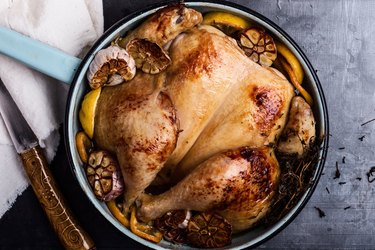
Whether fried, baked or boiled, chicken is versatile, tasty and widely eaten. But it can go bad. If your chicken is slimy after cooking, looks grey, smells bad or has visible mold, don't eat it.
This lean, healthy protein source — 3 grams of fat and 26 grams of protein in a 3-ounce portion, according to the USDA — needs to be properly cooked and stored to avoid risk of contamination and potentially illness.
Video of the Day
Video of the Day
Read more: General Nutrition Facts About Chicken
Avoid Undercooked Chicken
One of the easiest ways of telling if chicken is undercooked is if it is still pink on the inside. The USDA recommends cooking whole chicken to an internal temperature of 165 degrees Fahrenheit, measuring the temperature along the inside of the thigh and the thickest portion of the breast.
When using an instant-read thermometer, do not let the tip touch the bone as this will give a skewed reading. If cooking bone-in chicken, you will need a longer cooking time than deboned chicken, and stuffed chickens require longer cooking than chicken left as-is.
Cooked Chicken Looks Grey
Cooked chicken needs to be properly stored to stay safe for consumption. Freshly cooked chicken will have a brown or white color to the meat, and, over time, as it spoils, cooked chicken looks grey, or green-grey.
Other signs of spoiled cooked chicken are a bad, offensive smell, a chicken that's slimy after cooking, and mold or white spots on cooked chicken. In these cases, or whenever in doubt, throw away the chicken rather than risk potential contamination.
Beware Foodborne Illness
Foodborne bacteria can affect raw or cooked chicken and lead to cross-contamination — bacteria spreading from raw to cooked foods. According to the USDA Food and Safety Inspection Service, numerous bacteria can cause illness, including salmonella, listeria and E. coli. Common symptoms of all illnesses include abdominal pain or cramps, vomiting, nausea, diarrhea, fever and possibly respiratory complications.
To determine the specific course of treatment, you need to seek medical attention immediately. This will reduce the risk of more severe symptoms, including muscle paralysis and possibly death, depending on the type of bacteria.
Read more: How to Bake a Plain Chicken Breast
Store Chicken Safely
The USDA recommends storing all chicken — cooked or raw — in proper temperatures. Keep your fridge 40 degrees F or below, and your freezer no higher than 0 degrees Fahrenheit.
Refrigerate your leftovers within two hours of eating, or one hour if you're in hot temperatures of 90 degrees or more. Leaving food out longer than that can lead to harmful bacterial growth.
Don't eat cooked chicken that's been in the fridge for 7 days. In general, cooked chicken, if properly covered in the fridge, can be stored for three to four days, or upwards of four months in the freezer.
Raw chicken parts can be stored for one to two days in the fridge, or between three to 12 months in the freezer. If you are keeping your chicken warm before serving, keep it at 140 degrees or higher, and when reheating cooked chicken, bring it up to 165 degrees F.
- USDA Food Safety and Inspection Service: "Chicken From Farm to Table"
- USDA Food Safety and Inspection Service: "Foodborne Illness — What Consumers Need to Know"
- USDA FoodData Central: "Chicken, Breast, Roasted, Broiled, or Baked, Skin Not Eaten"
- USDA Food Safety and Inspection Service: "Keep Food Safe! Food Safety Basics"
Was this article helpful?
150 Characters Max
0/150
Thank you for sharing!
Thank you for your feedback!